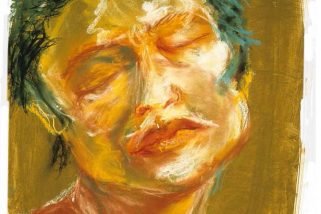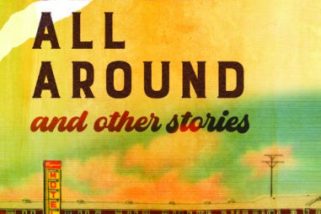“In the Attic” by Yenigün Batu; “Broken Bough” by Barbara Anne Kearney
“In the Attic” by Yenigün Batu
I always will be there, the cat in the attic.
My pointed ears are here to listen, the things you
won ́t say, but I do understand the beauty
And the dimness of your silence pulling me like a black hole.
Was I always like that?
I don ́t know.
I ́d love to listen, you know.
So you tell me a story, a piece of sycamore you are made of.
Sit down, child, you utter …
When was the last time you spoke?
Ages ago, there was life in you …
Every attic is mad in the eyes of them, yet they are the ones who build it.
Was it yours or mine?
Inherited, stereotyped, forced.
Yet, you are the one, the tamed lioness who saved me
From my shackles of shadows.
I hear what you say –
no one can help me but myself.
And now, I want to go back and say everything that
I didn ‘t in time. Isn ‘t it too late to wander on
The dusty cracking floor and come close to your
floor-to-ceiling window where you watch others?
If only I had opened it and pulled you out from the attic.
As an English major graduate who grew up in Turkey, I was surrounded by men telling women how to live and act, which resulted in changing the way I look at the world, seeing the injustice against women and my own female family members; thus I refuse to be silenced.
________________________________________________________________
“Broken Bough” by Barbara Anne Kearney
The maternal family tree—splintered, truncated. A withered specimen.
There are no lush branches and there is a lot of decay. It’s a tree of
stifled silence, standing in spite of itself, luminous on the horizon. For
more than 40 years I have sat on the most fragile of limbs— mostly
pruning (all that terribly garbled information!). But I have also done a
fair amount of grafting. Painstakingly, Unflinchingly. Lovingly. If I have
to, I am willing to try resuscitation.
~
It was at the Formica kitchen table with its chipped edges at 1430
North Rebecca Avenue in Scranton, Pennsylvania, when the first
strained and muted sounds of elegy reached my ears. I had asked for
a piece of paper and a pencil from my grandmother. I was about
twelve years old, and I wanted to draw the family tree.
We begin. My mother grows pensive as she moves deftly and matter-
of-factly through the information about her parents, and her mother’s
parents. But she blooms and lightens when she gets to her
Grandfather, Patrick, who was born, she thinks, in County Mayo,
around 1860, as best she can figure. “Shortly before Grandpa died, I
thought they said he made a trip back to Ireland. I always wondered
why.” This statement is meant as a query to her elder sister Mildred,
known as MoMo. Mildred is hunting around for her cigarettes, which
she keeps hidden behind one of the cookie tins. “I don’t remember
that,” her sister responds. “I just remember he always talked about
Connemara.”
Mildred has furtively and successfully tucked the pack of cigarettes
and a book of matches in the elastic waistband of her powder blue
slacks, and now has her eyes locked onto the porch screen door.
My mother considers this, then persists: “ If he went back to Ireland in
the 1930s, he must have gone to visit somewhere still there, someone
still alive.” She turns wistful, and seems to momentarily float beyond
my reach. “ I don’t know,” she says. “I just don’t know. I wish I did. I
really wish I knew more. He died when I too young, I was 14… a stroke
“, she trails off. “I really loved him. I remember walking home from
school and some of the neighborhood children were staring at me,
looking at me funny.” Pause. “He had passed away.”
I set the pencil down as I feel something rise and swell in me. In the
wake of my mother’s pained attempt to reconstruct the fractured
family narrative, I know now that I was being ushered into that vast
echo chamber of Lament. The tens of thousands of souls of that
tumultuous era of the late 18th and early 19th century, the mass
migration of Europe’s peasantry, still sounding, still resounding. Exile.
Destitution. Exploitation. Desperation.
I am the inheritor of my mother’s curiosity, regret and longing; it has
given me a peasant heart, nostalgic bearings, and this compulsion.
~
From my earliest years I experienced a strange kind of quickening at
any mention of the family dead. Perhaps every child does? It seemed
there were so many: a half-brother, three grandparents, eight great
grandparents, sixteen great greats. They all seemed to be lodged in
some ancient crevice of my heart, even those I could only begin to
fathom my way back to. Perhaps I felt this way because of something
in the matrilineal bloodline, something that lent us a more acute or
intuitive understanding of the dead’s grip and grasp upon the living?
After all, there’s my second cousin, Tom. His PhD was in geography
with a specialty in the social archaeology of cemeteries. In a local
newspaper interview once he attempted to wrest the moniker “Dr.
Death” from its ignoble origination with Dr. Kevorkian, the “mercy
killing” doctor. Shortly before he died, in the only conversation I had
with him, he was still pitching the title, still hoping it would stick. He
also told me that in the front lawn of his suburban home near
Pittsburgh were two headstones that he transported three hundred
miles from the family plot in Scranton, Pennsylvania. “I rescued them”,
he said. I wasn’t exactly sure what he meant, but I understood. I
remember him saying one grave marker belonged to the infant Molly,
died 1897, from his branch of the family tree. I also remember how
Tom chuckled at his own cleverness in having penned his epitaph,
”He’s not here yet.”
Perhaps the unnamed force field I felt myself being drawn into as a
child was because the resting places of some of the ancestors were far
from being places of repose. The remains of my great aunt Bridget’s
youthful, nimble leg lie some two hundred miles away from her frame.
Due to a doctor’s misdiagnosis, Bridget’s leg had to be amputated
after gangrene set in. As mandated by Catholic ritual, the limb is
buried in consecrated ground in Cathedral Cemetery in Scranton.
Bridget herself moved shortly afterwards to upstate New York, where
she died- but not until well into her eighth decade. Such a long life of
making do with truncated carriage and a crutch.
Bridget was one of the ones who left. One of the ones who stayed –
Bridget’s brother, Owen – was also missing a leg, though he was a
“cripple since birth.” My cousin Rose said her Grandmother told her
how the people in the village rigged an ass cart for Owen so that he
could play with the other children. I unearthed only one other story
about his life: “If you stopped in to see the bachelor Owen, you might
be noticing that he propped his wooden leg in the corner near the
stove when it was unstrapped”, the neighbors’ tongues wagged. On
that same trip to Ireland, I also learned that maybe, just maybe, there
is a reference to my Owen in a folksong lyric describing some locals at
the bar. “And over in the corner, there’s Ol’ Micky resting on his stick”.
I eventually traced Owen’s remains to an unmarked grave shared with
other unclaimed, indigent elderly of the “county home” in Sligo,
Ireland. And so, I wonder, could it be Owen and Bridget’s restiveness
that accounts for my own?
Is it any wonder my ancestral kin who emigrated couldn’t outrun that
other Irish scourge, eviction? There is the story of my great
grandfather’s brother. John Hannon was a recent widower with three
children, gravely ill at age forty-nine, facing eviction proceedings. He
was served the notice in a hospital bed. He died the next day- while a
lawyer moved by his plight was in court attempting to get a stay. His
girls, ages eleven and thirteen, were working in the silk mill in an
attempt to stave off the family’s complete collapse. His death invoked
this headline in the local newspaper: “Death Angel is Hannon’s Best
Friend in Need.”
Did we all have this watchful, wakeful companion at our side, the
Death Angel? No one seems quite sure of what happened to another
Tom in the family. Not many years into his new life in America, he met
his demise in a cement chute accident in New Jersey. My mother often
wondered whether this was the same Thomas that went out West, got
into some trouble, and spent time in jail? Or a different Thomas? And
there is Charlie, first generation American, who left home on a gasless
day to enlist in WWI and was never heard from or seen again. Was it
perhaps these mournful unanswered questions that created this potent
undercurrent of my yearning for ancestors and answers?
My great grandfather Patrick Hannon at least once narrowly escaped
death in the anthracite coalmines, where he spent nearly four decades
as a laborer in “King Coal’s” army. His accident was a common
occurrence- a dynamite blast gone wrong. His fellow miners – Polish.
Lithuanian, Italian, as well as Irish immigrants – were the
unaccountable, innumerable casualties of earth cave-ins and snapped
hoist cables. Their last intake of breath, ebony dust. Their last exhale,
hope. Trapped, sacrificed and dying with the American Dream stifled in
their craw.
I sometimes felt them as well, these not fully transfigured dead of the
mines, these ‘spirit kin’ to the caged canaries that were also brought
down into the mines to detect poisonous gas. Even after burial, these
men – and so many boys, like the ten-year-old breaker boy flattened to
death by a roller – had no surety. “Graves of the Dead Rocked by Mine
Caves” proclaims a Scranton newspaper headline from 1921. As a
miner came across another casket that had dropped down into a
mineshaft from a cemetery grave, I imagine him pausing briefly,
offering up a prayer, his headlamp flickering in a poor imitation of an
eternal flame. I know Patrick was one of these grim witnesses.
And my own Source? I was born to my parents in the autumn of the
year, late in a day in late September, late in my mother’s childbearing
years, twenty months after the death of my twenty-year-old half
brother in a car accident. I was conceived not so much out of the
longing of two people for each other, as from the woman’s need for
forgetfulness from her grieving. My birth was both a make-up and a
miracle after a tragedy, sort of a pre-ordained relief and rescue
mission.
Yes, from the beginning I loved my dead in a strangled, strangely
impassioned way. I felt a great responsibility. To give the vanquished
and forsaken ordinary lives the heft of significance, to transform the
dark weightlessness of these fractured shards, into something more
enduring, something that can be held and maybe handed to another—
like a pleasingly shaped, polished and lustrous stone. Or like coal
become diamond.
My inheritance, it appears, is to write elegy. My dead’s grasp on me is
firm, my birthright nothing less than the wasteful and useless effort of
restoring patina.
I am now living a pared down ‘beach shack’ life on the outer reaches of Cape Cod, Massachusetts, where I also am an open water swimmer and ‘small board/small wave’ rider. I collect paradoxes, embrace Instagramming, practice yoga, look for Swing dancing partners and otherwise tend to my late blooming.– Barbara Ann Kearney






